I can only assume that your fish tank is still battling that algae problem and you’ve finally decided to employ an “expert” cleaner to fight the intruder plant.

A common recommendation at this point is the true Siamese algae eater which in this subject is somewhat legendary, but is commonly mistaken for the flying fox or the Chinese algae eater.
Note that these latter two are almost completely useless in an aquarium environment.
What’s more, you are probably considering this fish because it will be beneficial to the cleanliness and ecosystem within your aquarium.
Still, even with a fish as common as this algae eater, many questions are difficult to track down outside of a dedicated fish reading book.
They kind of look like small sharks, but are they aggressive toward their tankmates?
Can they be kept singly or they thrive in groups?
How many do you actually need for a happy fish tank environment?
What is the maximum size of a full-grown SAE?
How complex is their care sheet?
Let’s go through a quick summary of the things you need to know about the Siamese algae eater and some of the most common mistakes new owners make.
In fact, it will consume almost all types of algal growth, including hair algae.
As you may already know, unfortunately, algae are a form of pest vegetation that’s difficult to eradicate, even after repeatedly taking measures against it.
The algae eater in question, however, is constantly on the look for food.
This has made the SAE a wonderful addition to most aquarium setups as it’s a loveable fish in its own right but is also useful in a balanced ecosystem.
Quick Facts About the Siamese Algae Eater
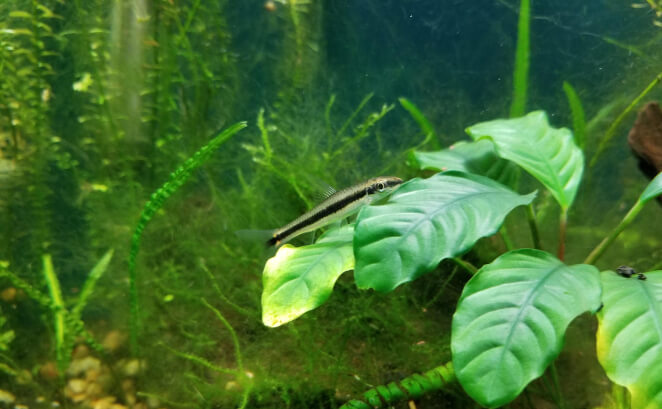
By Irecruitfish
Originating in the Malayan Peninsula and Thailand, Siamese algae eaters are bottom-dwelling fish native to small streams and rivers.
Sometimes they populate flooded forests where they feed on the algae that dominate in these ecosystems.
They work together in large schools picking clean algae growth on rocks and plants in the waters. They are technically part of the carp family, Cyprinidae, and known as Crossocheilus Siamensis.
Sometimes you can find them falsely labeled as a “Siamese Flying Fox” in the aquarium trade.
SAEs have a brownish-beige coloration, except for their nearly translucent clear caudal fin.
They also have a black stripe that runs the length of their body, brushing the aforementioned fin.
Despite their name, these so-called algae eaters are true omnivorous fish feasting on algae, phytoplankton, and even zooplanktons.
Their diet and behavior change depending on the food sources in their environment, making them incredibly adaptable when compared to other algae eaters.
This means they’re almost constantly in motion so they don’t completely sink and maintain buoyancy.
They are, therefore, quite efficient at their jobs and interesting to watch darting around for their next meal.
Their diet mainly consists of hair-like algae though they are omnivores by nature so they will feed on most commercially available fish foods as well.
The difference between a true Siamese Algae Eater and a flying foxfish or a Chinese algae eater
It’s important to know the difference between a real Siamese algae eater and its lookalikes.
The “imposters” are often purchased and sold accidentally due to a lack of knowledge on the subject by either the purchaser or the store itself.
Here’s how to tell apart a true Siamese algae Eater from a flying fox fish or a Chinese algae eater:
The difference between a True Siamese algae eater and a Flying Fox, by far the most commonly confused, can be seen easily in their fins. You can tell a real Siamese algae eater apart from the flying fox fish by its fins, which are almost entirely clear, with only a bit of black reaching its caudal (tail) fin.
That being said, here’s a visual representation of the differences, that may further help you with the identification:
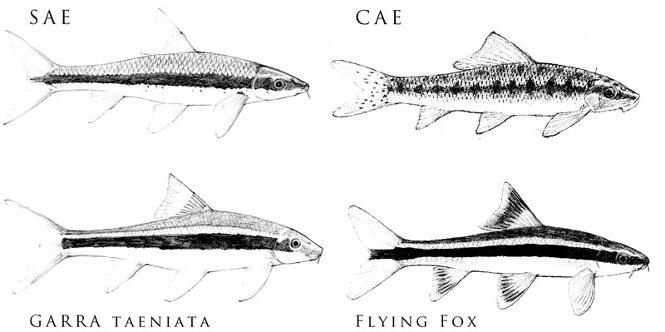
The Flying Fox will have black on both its bottom and top fins, which the true Siamese algae eaters will never have.
As far as Chinese algae eaters (CAE) go, identification mistakes are less often made but they do happen.
The black stripe is much more ragged on a CAE and only looks similar to a completely untrained eye.
This is not to say a fish store won’t confuse them. They deal in a large amount of fish and many of the workers aren’t fully trained to identify these similar-looking species. Beware of this common pitfall.
Siamese algae eaters also have a somewhat shark-like appearance. People actually add them to their freshwater “shark tanks” full of other fish with similar looks.
Here’s a shot from one such shark tank where a Siamese algae eater is schooling with Dension barbs:
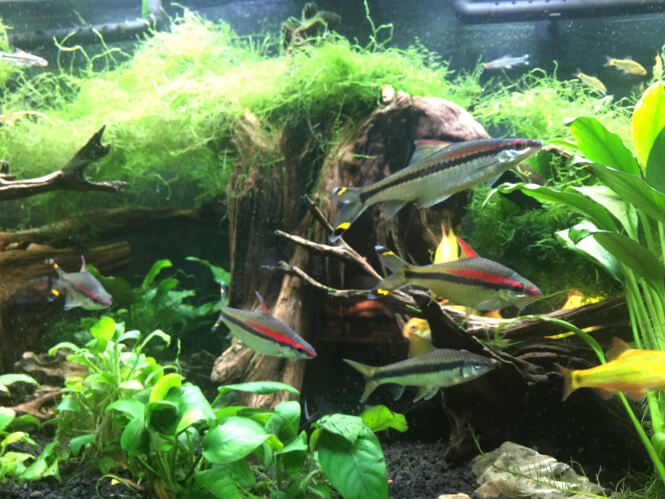
By SilasX93
A full-grown specimen and suggested aquarium size
So, we’ve covered the behavior of the Siamese Algae Eater and its identification but now it’s time to talk size. This is one of those fish that grow much larger than you might expect at first glance.
Here’s how big the Siamese algae eaters get in an aquarium environment:
A true Siamese algae eater grows to a maximum size of about 6″ (16 cm) in an ideal environment. However, to get one to reach its full length of 6 inches it has to be well cared for and in an aquarium large enough to support its swimming needs.
With that said, it will take anywhere between 6 months and 2 years for a Siamese Algae Eater to reach its full size.
It is generally recommended to have at least a 30-gallon tank and 36 inches of horizontal aquarium length to fully let the Siamese algae eaters stretch out. Since they are accomplished escape artists, you’ll also want to use a glass lid to keep them from jumping out of your tank.
Siamese Algae Eaters are indeed schooling fish that like to swim together and therefore need to have sufficient room to move about. Possibly more for mature ones as you will need to have them schooling together at full size.
Here’s a photo of fully grown SAE that looks quite bulky:
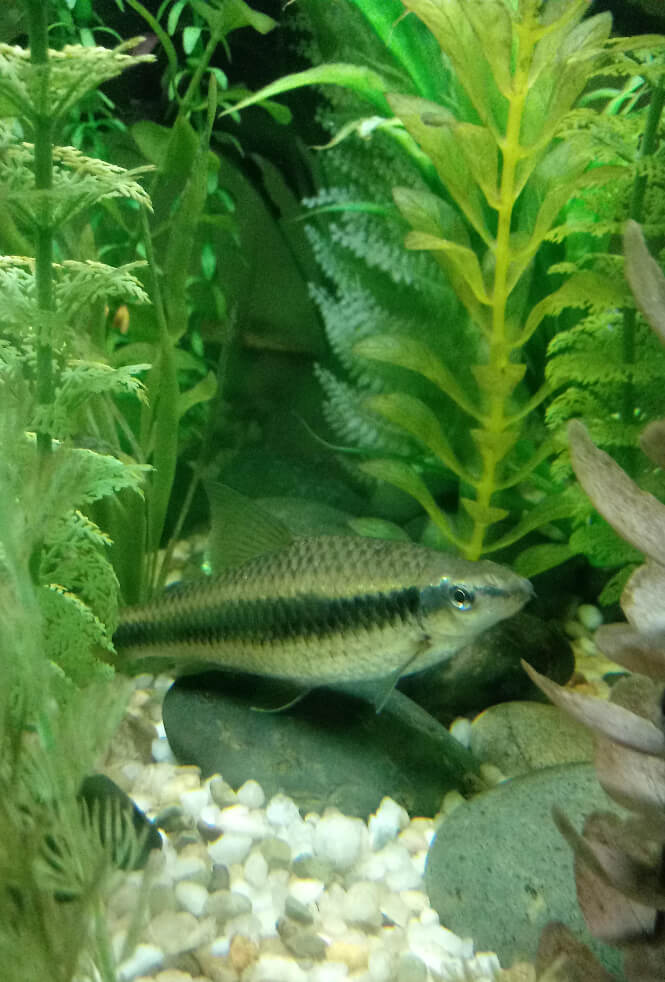
By Cezh_work_GSD_Scout
Water parameters and environment
In the wild, the Siamese Algae Eater inhabits medium-sized rivers and streams with low water flow.
It’s typically found in clear, shallow waters with abundant sunlight.
These areas often contain fallen logs, driftwood or branches, which SAE utilize as shelter.
Due to this, they prefer a slightly acidic water with a pH between 6.5 to 7.0 and water hardness around 5-20 dH.
Since they’re tropical fish, siamese algae eaters require a water temperature of 75 – 79°F.
Similar to other species that live in flowing waters, they’re fairly sensitive to waste buildup, so regular water changes shouldn’t be skipped.
Even though it’s not essential, these algae eaters appreciate highly oxygenated waters that remind them of their natural habitat.
To spark their nostalgia, you’ll need to use an airstone, and furnish their home with aquarium vegetation.
Picking the right plants can be a bit tricky, since siamese algae eaters tend to do best with smooth gravel substrates that don’t damage their barbels.
Moreover, they need to be provided with plenty of shelter in the form of driftwood, caves and tree branches.
Since there aren’t many plants that can be grown under these conditions, you’ll have to rely on hardy species such as the Anubias spp. or Microsorum.
Apart from the increased oxygenation, the plants will also provide additional refuge for your SAE.
However, you should be aware that the SAE might try to eat some of the plants if it’s hungry.
Recommended foods for a balanced diet for Siamese Algae Eaters
As important, for growing your fish healthily is maintaining the proper nutritious food for them as a balanced diet will ensure the longevity of your algae eaters.
Their name obviously suggests that they feed mostly on algae.
This is true, but there is some nuance to this that needs to be accounted for.
To supply a Siamese algae eater with adequate food sources you should consider that:
Siamese algae eaters enjoy eating green hair algae to an extent that some fishkeepers cultivate that on purpose. However, you should be supplementing its menu with commercially bought algae wafers, live food, catfish pellets, and meaty foods as well.
A true SAE will destroy algae clusters quicker than you may expect. I have listed them among my top recommendations when it comes to a quick and efficient clean of an aquarium.
However, take note that if they are provided a diet too rich in proteins they may forget algae entirely and begin to subsist solely on commercial foods.
Give them algae and let them forage about the tank. Provide them with meatier foods sparingly as more of a treat from time to time.
I have seen some people suggesting to half-starve the creatures to ensure they will always be on the lookout for algae.
I find this approach a little extreme and would not recommend it, as it somehow feels like exploiting.
It is possible to stimulate the appetite for algae in an SAE without torturing it with fasting periods.
It has been my experience that keeping the proportion of vegetables to meat at 80% to 20% in the algae eater’s diet will produce good results, without compromising on vitamin intake.
You can experiment with this somewhat, just be sure not to overfeed if you wish for them to remain effective aquarium cleaners.
Will a Siamese Algae Eater consume black beard or other hard hair algae?
The Black beard algae are one of the most difficult hair algae species to get rid of. It will survive treatments of most common algaecides and this makes it quite the pain for aquarium owners. Luckily, the SAE has your back here.
Real Siamese algae eaters possess an appetite for and will consume large quantities of black beard algae. In fact, they will eat all hair algae, which makes them significantly beneficial to most home aquariums.
This picture was taken while a Siamese algae eater eats leftover black algae:
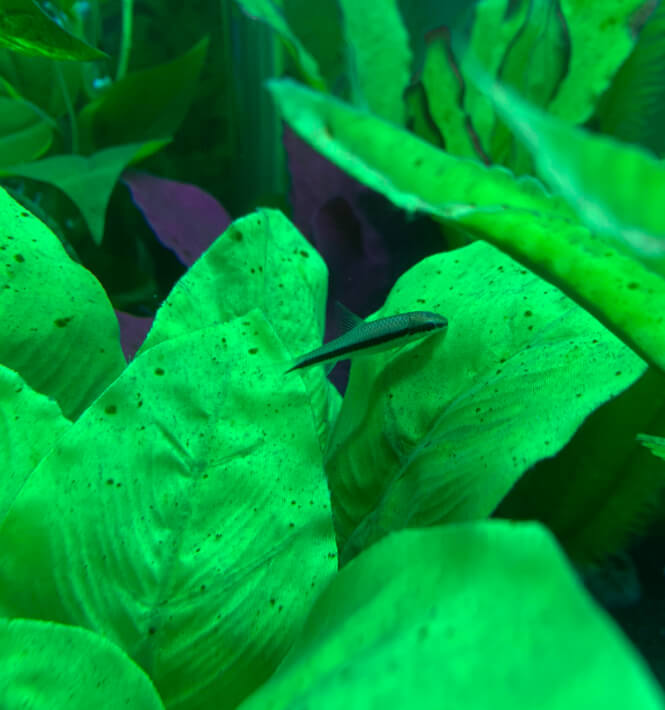
By mervyn96
And here’s video proof of that on YouTube.
Truly, there isn’t a product out there that works as effectively as a real Siamese algae eater, but that’s only if they have the appetite going.
What do I mean by that?
If there are not many other aquatic plants and the Carbon Dioxide level in the aquarium is low, the beard algae become stiff and unappetizing for algae eaters.
In that case, you’ll need to first supply your aquarium with some more freshwater plants or at least add more CO2.
This will affect the black hair algae in a way that it will become easier to chew on and get eaten by the algae grazers.
It’s also worth noting that there’s not a distinctive time period before the Crossocheilus Siamensis starts developing an appetite for black algae.
If your Siamese algae eater won’t show interest in grazing on this particular type of algae, it may mean that the fish has either been raised with mainly commercial-grade food or the black beard algae is too stiff.
Don’t think about it too much though, as this is rarely the case.
Be sure to keep their diet regulated properly as mentioned above, and soon after introducing this fish to a system, not only the black but all hair algae will no longer be a problem.
Perceived temperament of the Siamese algae eater
For the most part, the Siamese algae eater is not an aggressive fish. It’s classified as peaceful and it will not harm other inhabitants in a fish tank.
There is, however, one caveat to this.
The males are somewhat territorial among each other. This happens mainly if the school is not large enough.
They need either be with no others of their kind or in a fairly large group of about 5 or more. Because of this temperament trait, it’s advisable to purchase only female Siamese algae eaters if you want a group. However, I strongly recommend getting a single specimen over a group to avoid issues in the future.
Anyway, you can only tell the females apart from the males when the fish is mature.
The female Siamese Algae Eater would have around 30% more body mass than a male one, for the same body length.
This would mean that females appear more round, whereas male Siamese Algae Eaters appear more elongated.
Here’s a photo of a pair of Siamese algae eaters swimming side by side:
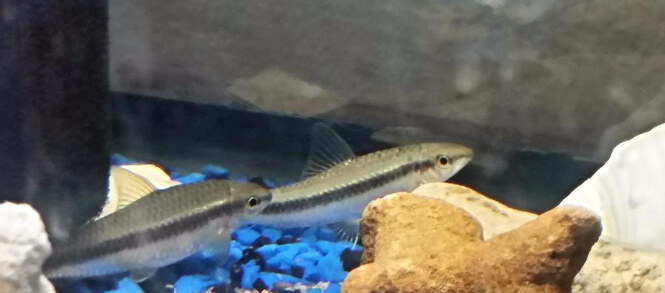
By Drewet88
Though it would probably the better option, picking females over males is not a necessity. If you’re getting just one Siamese Algae Eater for your tank, then the gender of the fish does not matter at all.
In either case, these algae eaters are perfect for a community aquarium with other peaceful aquatic inhabitants, and will not harm other fish species.
Recommended tank companions
A tank with just SAE’s in it will do just fine, however, this isn’t most people’s ideal set up.
Caution should be taken, as even though the SAE is a relatively peaceful fish it will not do well if there are aggressive tank mates in the aquarium.
Here are the generally recommended tank mates for a Siamese algae eater:
Ideal companions for a Siamese algae eater are that of other community type fish. Your Gouramis, schools of Barbs, Tetras or Danios, Angel Fish, Guppies, swordtails, or cory cats will all do fine alongside your algae eater as tank mates.
If you’d like you can check my list on the best community fish for more details.
Other Siamese algae eaters, are also great companions to keep around as they will naturally school together, but make sure you pick mostly females.
This means no Red Tail Sharks, for example, which are the classic example of this unhealthy interaction.
If you have a pleco in there, make sure it has a shy personality and that it remains small in size, such as the rubber lipped pleco. For more ideas you can also check my list on the best small pleco fish.
Anyway, for Pleco/SAE combination to work, it’s important to maintain a temperature range that’s healthy for both species. Most plecos are the type of fish that prefers slightly colder aquariums, but the temperature range overlaps with the recommended one for an SAE. Aim for 75 to 76°F (23.9 to 24.4°C) in this setup.
Cichlids are also problematic, though most of them should be kept in a species only tank anyways.
The exception to this is the somewhat peaceful angelfish which does just fine around SAEs.
Other non-fish companions work exceptionally well – snails and shrimp are all great choices if you’d like to add some diversity to the movements around the tank.
Where to buy one?
The Siamese algae eaters are widely available at most physical aquarium stores, as they are very useful and popular fish.
Be sure to be on the lookout for the black stripe and clear fins and you should have no problems with getting the right species.
Don’t always trust the label, use your knowledge to identify a real Siamese algae eater.
Most are priced fairly low at around 5 dollars, though a larger specimen may cost more if it’s from a reputable breeder.
Your other option would be to buy a Siamese Algae Eater from an online fish store or a local vendor. I’d recommend getting yours from a place that specializes in selling freshwater aquarium fish in particular. I’ve selected the best ones in the link.
Anyway here’s a photo of someone getting theirs for only $2.49:
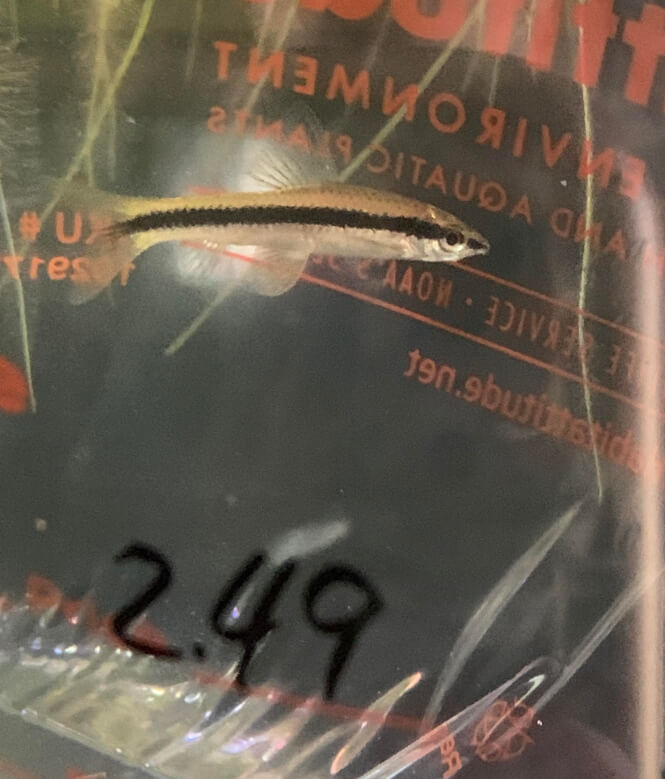
By mia0416
Tips for taking proper care of Siamese Algae Eaters
As you can see from what I’ve covered so far these fish are fairly low maintenance and can be a huge help to any fish tank that doesn’t house aggressive bottom feeders.
The big thing to reiterate, however, is to be sure that the species is indeed a true Crossocheilus Siamensis and not one of its less helpful cousins and lookalikes.
Here are tips on selecting and caring for a Siamese algae eater:
- Make sure your algae eater has clear dorsal and lower fins with only a small bit of black reaching its caudal fins.
- Provide the SAEs with enough room to school, eat, and grow properly. The bare minimum fish tank size is 30 gallons and 36 inches in length.
- Avoid an overabundance of protein-rich foods, as they will ignore the algae if regularly fed with that.
- A properly taken care of SAE will reach around 6″ in length, so be sure to accommodate that level of growth.
- Do not place this algae eater with aggressive fish, they only do well in a peaceful environment.
- The fish must either be kept alone or within a school of 5 or more, as territorial disputes can happen otherwise.
- Remember that an SAE does not have a swim bladder, so it will move around quite a bit while foraging for food, which may stress slow-swimming fish.
- Have a lid installed on your fish tank, as these fish are well-known jumpers.
If you take into account all of this you should have little to no issue introducing a Siamese algae eater into your home aquatic system.
Here’s how a healthy and well-cared for Crossocheilus Siamensis specimen looks like:
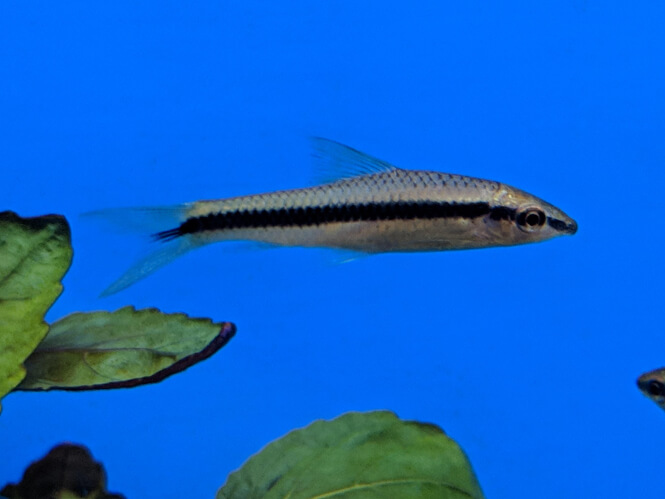
By mwardwell
My Final Thoughts
Despite me going on at length on how to take care of the Siamese algae eater fish, they’re really not a complex species to look after.
I only want to properly inform beginner aquarium enthusiasts to ensure a beneficial relationship between them, the fish tank owner, and the fish that will act as an incredibly effective cleaner for their setup.
Honestly, you will love yours once they have acclimated to your tank. It really may surprise you how quickly even an algae-infested tank can be picked and cleaned by these remarkable fish.
It’s quite enjoyable watching as well, as they’ll roam around the fish tank restlessly.
Leave a comment if you think there’s something you want to discuss or if you want more help with the species.

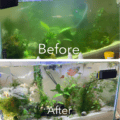
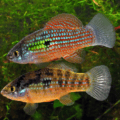
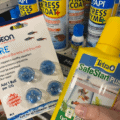
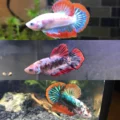

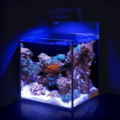

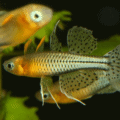


I bought 2 was told they were fully grown at about 1inch. I love them and they are living with everything you mentioned except angels. 😂 Thanks for the excellent advice. Can I ask, is there a possibility of when they get bigger could they be put in a pond during the summer? Water temperatures around 22°.
I have definitely identified my new purchase as a SAE.
He is pretty good size ( about 2″) long, with some nice size, bit appears male.
The problem is, he appears quite lazy.
Maybe he’s new to the tank and just getting accustomed.
What do you think?
Thank you very much.
I bought a SAE under Siamese Fly Fox label. And I saw Siamese Fly Fox under SAE label in another store. It’s tricky, isn’t it?